Vertical Farming Market Size
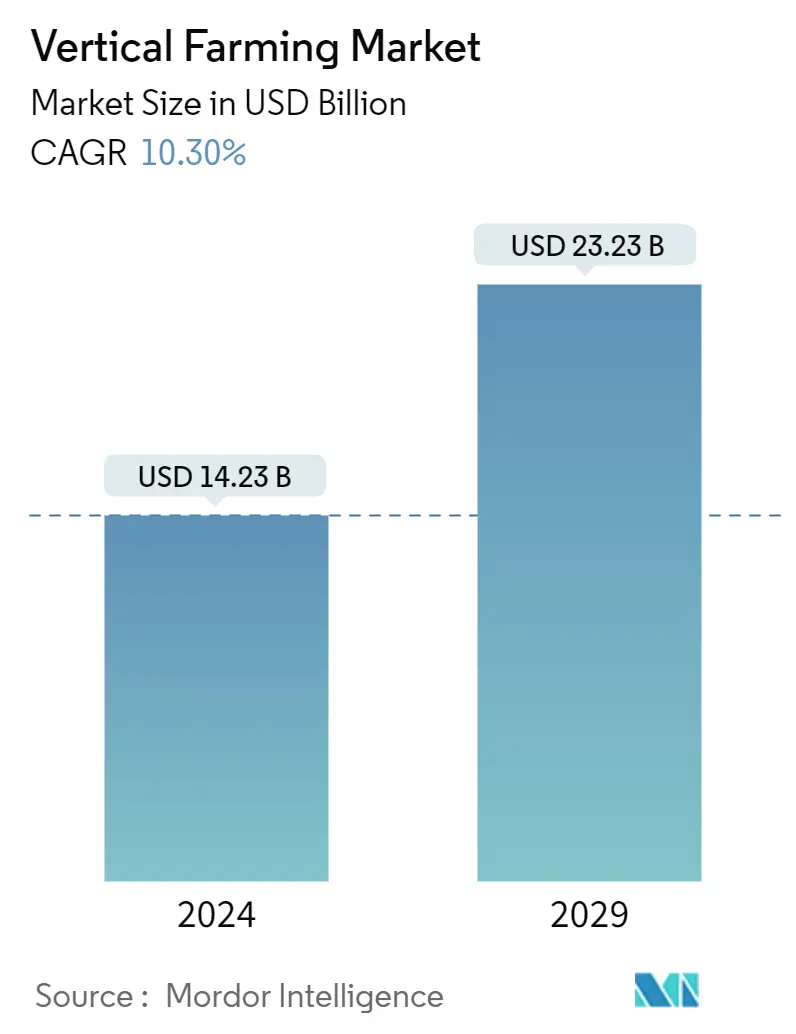
| Study Period | 2018 - 2029 |
| Market Size (2024) | USD 14.23 Billion |
| Market Size (2029) | USD 23.23 Billion |
| CAGR (2024 - 2029) | 10.30 % |
| Fastest Growing Market | Asia-Pacific |
| Largest Market | North America |
| Market Concentration | Low |
Major Players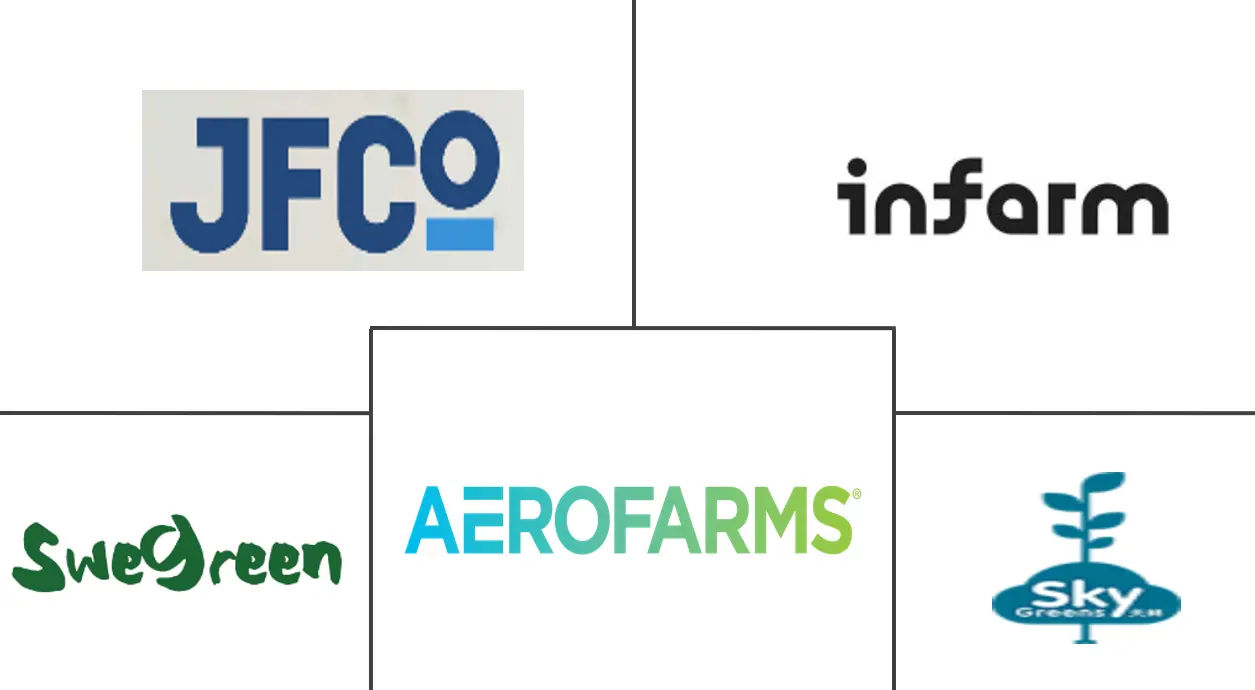
*Disclaimer: Major Players sorted in no particular order |
Vertical Farming Market Analysis
The Vertical Farming Market size is estimated at USD 14.23 billion in 2024, and is expected to reach USD 23.23 billion by 2029, growing at a CAGR of 10.30% during the forecast period (2024-2029).
- The increased demand for organic products among consumers, fueled by the improved standard of living and higher disposable income paved the way for the development of vertical farming, wherein organic farming is practiced widely. People are growing the necessary crops in their own houses on a small scale to have food free from pests. An increase in health consciousness and consumption of residue-free food has paved the way for the usage of advanced techniques, like hydroponics, aeroponics, etc.
- Microgreens are among the crops cultivated by vertical farming methods and are a rich source of polyphenols, a class of antioxidants that helps to lower the risk of diseases, such as heart disease, Alzheimer's disease, diabetes, and certain cancers.
- With the growing innovation in agricultural technology, the industry is growing rapidly, attracting individual as well as commercial attention. Many commercial growers are adopting high capital expenditure technologies, such as advanced hydroponic systems and electronic traceability systems. Additionally, growers are heavily investing in LEDs and other innovative lighting products to reduce their exposure to associated risks by carefully monitoring and investing in new technologies.
- The need for food supply against the explosive population is expected to increase by 2050, which has catalyzed the growth of the vertical farming market. Funds are being invested in the market to bring developments and technological advancements to this specific sector. The control over the growth of plants and the minimum resource requirements in terms of space, water, etc. is making this technique more popular as the global food crunch is around the corner in many parts of the world. The increased need to meet the demand of the growing population and limited and scarce agricultural land and water are anticipated to drive the global market for vertical farming during the forecast period.
Vertical Farming Market Trends
Shrinking Agricultural Land Area
Increasing population trends, urbanization, decreasing water supply, and continuing climate change contributed to the declining arable land stocks per person. Due to the continuous decline in per capita farmland availability, a possible way out is the practice of increasing productivity. Thus, there is a need to increase yield from the available land, which can be achieved through vertical farming.
According to the United States Department of Agriculture (USDA), farmers in the United States voluntarily removed land from crop production because of poor growing conditions or constrained irrigation water supplies. Especially with the demand for organic and sustainable products increasing the drop in yield is affecting the margin of the farmers. Gradual declines have occurred in cropland, while grazed forestland decreased more rapidly. According to the USDA report area of land on farms has been decreasing year by year, in 2017 the area was reported to be 364.36 million hectares and in 2021 it dropped to 362.31 million hectares.
In the case of China according to FAO data, there has been no increase in the arable land but a slight negligible decline in the land area from 2017 to 2020, where it is reported to be 119.47 million ha. The increasing population in China created a food demand which in turn pushes the farmers toward vertical farming techniques. With the aid of technology, farmers are registering higher yields while using lesser resources.
Thus, vertical farming, which involves greater use of technology and automation for land-use optimization, exemplifies solutions for improving future food production.
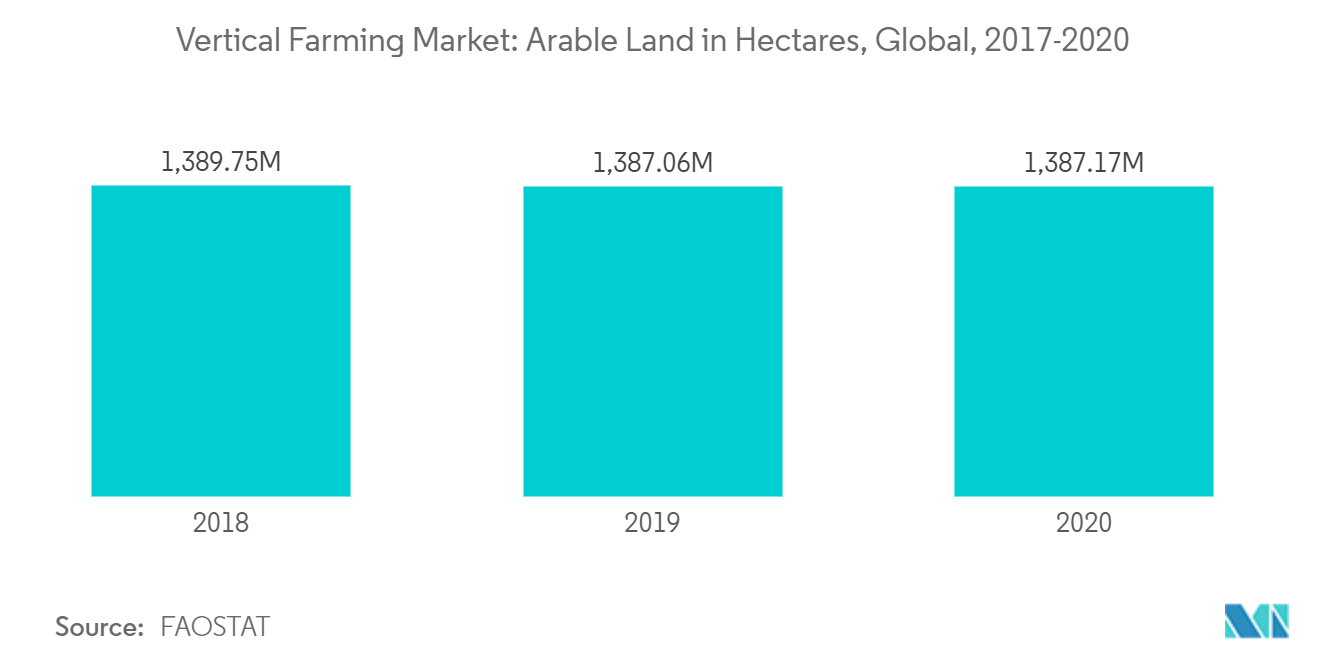
North America Dominates the Market
The United States market dominated the North American region. Growing concerns about food security and nutrition are expected to open several novel opportunities for the industry to prosper. The United States is anticipated to invest a significant share in facilitating the ecosystem for future foods. As more consumer insights develop toward 'fresh-from-farm-to-table,' the availability of freshly harvested vegetables across retail outlets is expected to increase in the country (which is also the pioneer in adopting this concept). The onset of urban population dwellings across cities, such as New York, Chicago, and Milwaukee propelled the environment for vertical farming with activities, such as revamping derailed vacant warehouses, derelict buildings, and high rises, which has, in turn, led to an increase in the production of fresh grown foods altogether.
There are new aeroponic systems that are set to begin and are under construction. For instance, earlier this year, in 2022, Brooklyn-based Upward Farms unveiled its plans to launch a massive 250,000-square-foot vertical farm located in Northeastern Pennsylvania's Luzerne County. It is set for an early 2023 opening and the farm will specifically focus on microgreens.
Furthermore, according to the March 2020 report by Ontario's Greenbelt Foundation, at least four vertical farms are operating in B.C., at least two in Alberta, six in Ontario, and one in Nova Scotia. Major players in the Canadian vertical farm industry are Canada's Modular Farms, based in Toronto, and Nova Scotia's TruLeaf, leading the trail, followed by startups, such as Ecobain Gardens, growing rapidly in terms of the area used, by engaging the fresh herb mix concept. The main hydroponic systems used in Mexico are the drip irrigation and Nutrient Film Technique system. The maximum number of per-acreage hydroponic installations was recorded in the Distrito Federal province of Mexico. Thus, the expansion of companies to the vertical farming market through increased investment is anticipated to drive the growth of the market studied during the forecast period.
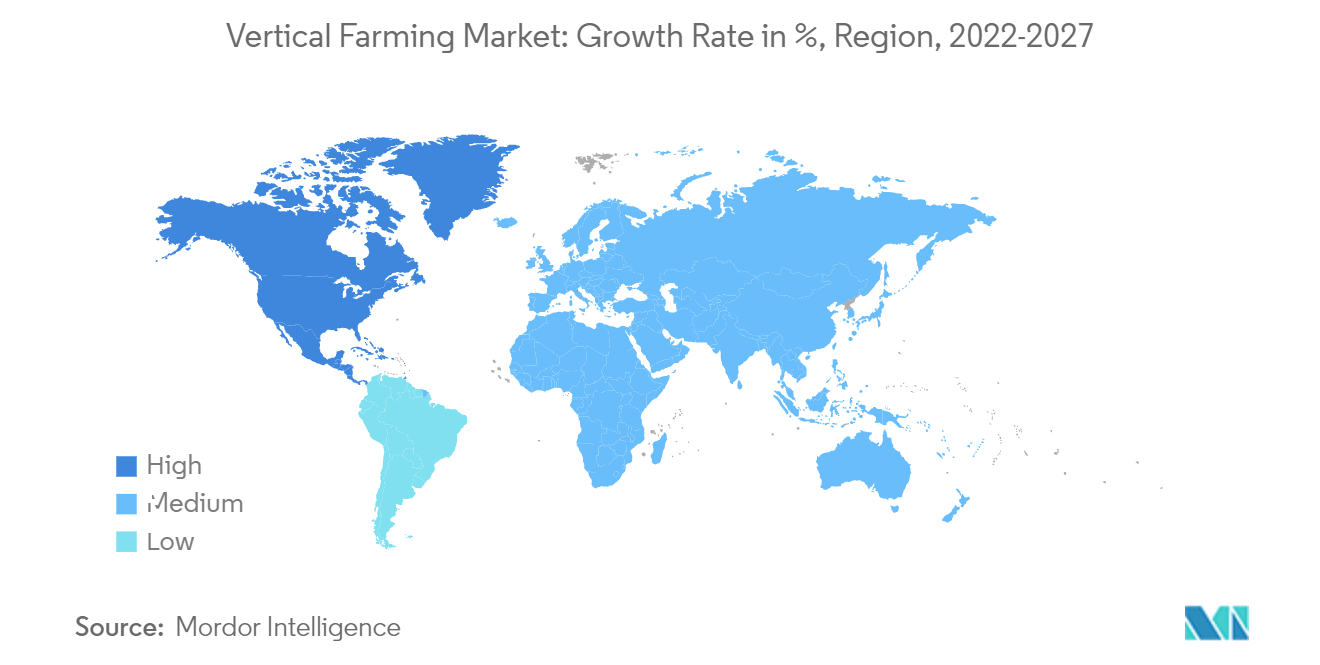
Vertical Farming Industry Overview
The market is highly fragmented, with major revenue-generating companies such as Aerofarms, InFarm, Jones Food Company, and Swegreen, among others, cornering just some part of the market share, while the rest of the market is shared among numerous players, such as Sky Greens Pte Ltd, Agricool, Future Crops, V-Farm, etc.
Vertical Farming Market Leaders
-
Aerofarms
-
Infarms
-
SweGreen
-
SkyGreens Pte Ltd
-
Jones Food Company
*Disclaimer: Major Players sorted in no particular order
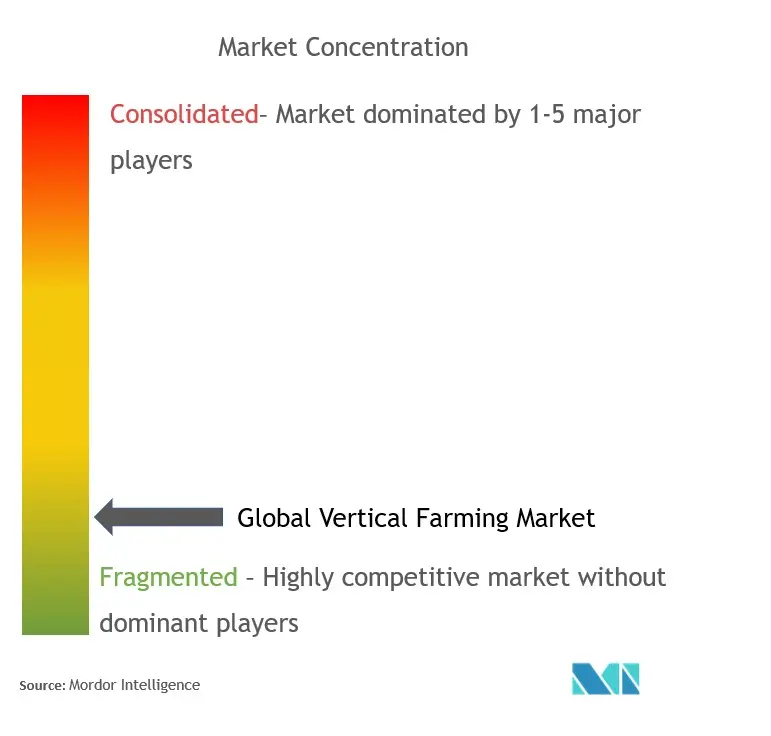
Vertical Farming Market News
The new players entering the indoor vertical farming market can fetch profits by choosing the most profitable crops and using the correct facility systems. The companies are also trying to span the globe to capture the markets early, especially in Asia-Pacific regions.
October 2022: AeroFarms have decided to expand nationwide from the Northeast region to all whole food markets, especially after seeing increasing demand for their specialty green. AeroFarms will be the first indoor farming company to be part of the Whole Foods Market Global Planogram.
October 2022: Singrow, a Singapore-headquartered agtech company planned to expand across and beyond Asia and launch its consumer concept brand Blooom. The company plans to increase its partner farm footprint to the Philippines, Thailand, Hong Kong, and the Middle East, beyond its current presence in China, Indonesia, and Singapore.
February 2022: Infarm is planning to expand in the United States, by building its second growing center in kyle, the center is said to be 50,000 sqft, and expected to produce 2.2 million pounds of salads per year.
Vertical Farming Market Report - Table of Contents
1. INTRODUCTION
1.1 Study Assumptions and Market Definition
1.2 Scope of the Study
2. RESEARCH METHODOLOGY
3. EXECUTIVE SUMMARY
4. MARKET DYNAMICS
4.1 Market Overview
4.2 Market Drivers
4.3 Market Restraints
4.4 Industry Attractiveness - Porter's Five Forces Analysis
4.4.1 Bargaining Power of Suppliers
4.4.2 Bargaining Power of Buyers
4.4.3 Threat of New Entrants
4.4.4 Threat of Substitute Products
4.4.5 Intensity of Competitive Rivalry
5. MARKET SEGMENTATION
5.1 By Growth Mechanism
5.1.1 Aeroponics
5.1.2 Hydroponics
5.1.3 Aquaponics
5.2 By Structure
5.2.1 Building-based Vertical Farms
5.2.2 Shipping Container-based Vertical Farms
5.3 By Components
5.3.1 Lighting
5.3.2 Climate Control
5.3.3 Sensors
5.3.4 Other Hydroponic Components
5.4 By Crops
5.4.1 Tomato
5.4.2 Berries
5.4.3 Lettuce and Leafy Vegetables
5.4.4 Pepper
5.4.5 Cucumber
5.4.6 Microgreens
5.4.7 Other Crop Types
5.5 By Geography
5.5.1 North America
5.5.1.1 United States
5.5.1.2 Canada
5.5.1.3 Mexico
5.5.1.4 Rest of North America
5.5.2 Europe
5.5.2.1 United Kingdom
5.5.2.2 France
5.5.2.3 Sweden
5.5.2.4 Rest of Europe
5.5.3 Asia-Pacific
5.5.3.1 Singapore
5.5.3.2 China
5.5.3.3 Japan
5.5.3.4 Taiwan
5.5.3.5 Rest of Asia-Pacific
5.5.4 South America
5.5.4.1 Brazil
5.5.4.2 Rest of South America
5.5.5 Africa
5.5.5.1 South Africa
5.5.5.2 Rest of Africa
6. COMPETITIVE LANDSCAPE
6.1 Most Adopted Strategies
6.2 Market Share Analysis
6.3 Company Profiles
6.3.1 Aerofarms LLC
6.3.2 Sky Greens
6.3.3 IGS Limited
6.3.4 Everlight Electronics Co. Ltd
6.3.5 Freight Farms
6.3.6 Agrilution GmbH
6.3.7 American Hydroponics
6.3.8 Urban Crops Solutions
6.3.9 Vertical Farm System
6.3.10 Gronska Stadsodling AB
6.3.11 V-Farm
6.3.12 Growup Farms Ltd
6.3.13 Vertical Future Ltd
6.3.14 SweGreen
6.3.15 Jones Food Company
6.3.16 InFarm
6.3.17 Agricool
6.3.18 Future Crops
6.3.19 GrowY
6.3.20 Intelligent Growth Solutions Limited
7. MARKET OPPORTUNITIES AND FUTURE TRENDS
Vertical Farming Industry Segmentation
Vertical farming is a farming method through which crops are grown in vertically stacked layers. It is done in a controlled environment using techniques, such as aquaponics, hydroponics, and aeroponics that do not make use of soil.
The Vertical Farming Market is segmented by Growth Mechanism (Aeroponics, Hydroponics, and Aquaponics), Structure (Building-based Vertical Farms and Shipping Container-based Vertical Farms), Components (Lighting, Climate Control, Sensors, and Other Hydroponic Components), Crop (Tomato, Berries, Lettuce and Leafy Vegetables, Pepper, Cucumber, Microgreens, and Other Crop Types), and Geography (North America, Europe, Asia-Pacific, South America, and Africa). The report offers market estimation and forecasts in value (USD million) for the above-mentioned segments.
| By Growth Mechanism | |
| Aeroponics | |
| Hydroponics | |
| Aquaponics |
| By Structure | |
| Building-based Vertical Farms | |
| Shipping Container-based Vertical Farms |
| By Components | |
| Lighting | |
| Climate Control | |
| Sensors | |
| Other Hydroponic Components |
| By Crops | |
| Tomato | |
| Berries | |
| Lettuce and Leafy Vegetables | |
| Pepper | |
| Cucumber | |
| Microgreens | |
| Other Crop Types |
| By Geography | |||||||
| |||||||
| |||||||
| |||||||
| |||||||
|
Vertical Farming Market Research FAQs
How big is the Vertical Farming Market?
The Vertical Farming Market size is expected to reach USD 14.23 billion in 2024 and grow at a CAGR of 10.30% to reach USD 23.23 billion by 2029.
What is the current Vertical Farming Market size?
In 2024, the Vertical Farming Market size is expected to reach USD 14.23 billion.
Who are the key players in Vertical Farming Market?
Aerofarms, Infarms, SweGreen, SkyGreens Pte Ltd and Jones Food Company are the major companies operating in the Vertical Farming Market.
Which is the fastest growing region in Vertical Farming Market?
Asia-Pacific is estimated to grow at the highest CAGR over the forecast period (2024-2029).
Which region has the biggest share in Vertical Farming Market?
In 2024, the North America accounts for the largest market share in Vertical Farming Market.
What years does this Vertical Farming Market cover, and what was the market size in 2023?
In 2023, the Vertical Farming Market size was estimated at USD 12.76 billion. The report covers the Vertical Farming Market historical market size for years: 2018, 2019, 2020, 2021, 2022 and 2023. The report also forecasts the Vertical Farming Market size for years: 2024, 2025, 2026, 2027, 2028 and 2029.
What emerging technologies are shaping the Vertical Farming Industry?
The emerging technologies shaping the Vertical Farming Industry are a) AI-powered automation b) Robotics c) Advancements in LED lighting technology
Vertical Farming Industry Report
The global vertical farming market is experiencing remarkable growth, this growth is driven by the adoption of sustainable methods for fruit and vegetable production, leveraging advanced technologies such as hydroponics, aeroponics, and LED lighting in controlled environments. This ensures consistent crop yield year-round, addressing food security concerns amidst increasing global urbanization and population. North America, notably the United States, is making substantial investments in vertical farming, with projects like the large-scale vertical farm in Pennsylvania focusing on microgreens, showcasing the region's commitment to 'fresh-from-farm-to-table' concepts. Despite facing high initial investment costs, the industry is propelled forward by innovations in robotics, AI, and IoT, enhancing efficiency from irrigation to harvesting. Insights from ����vlog��ý™ highlight the top vertical farming companies contributing to the market's expansion, indicating a promising future for vertical farming in meeting the growing demand for high-quality, organic food. Get a sample of this industry analysis as a free report PDF download.



